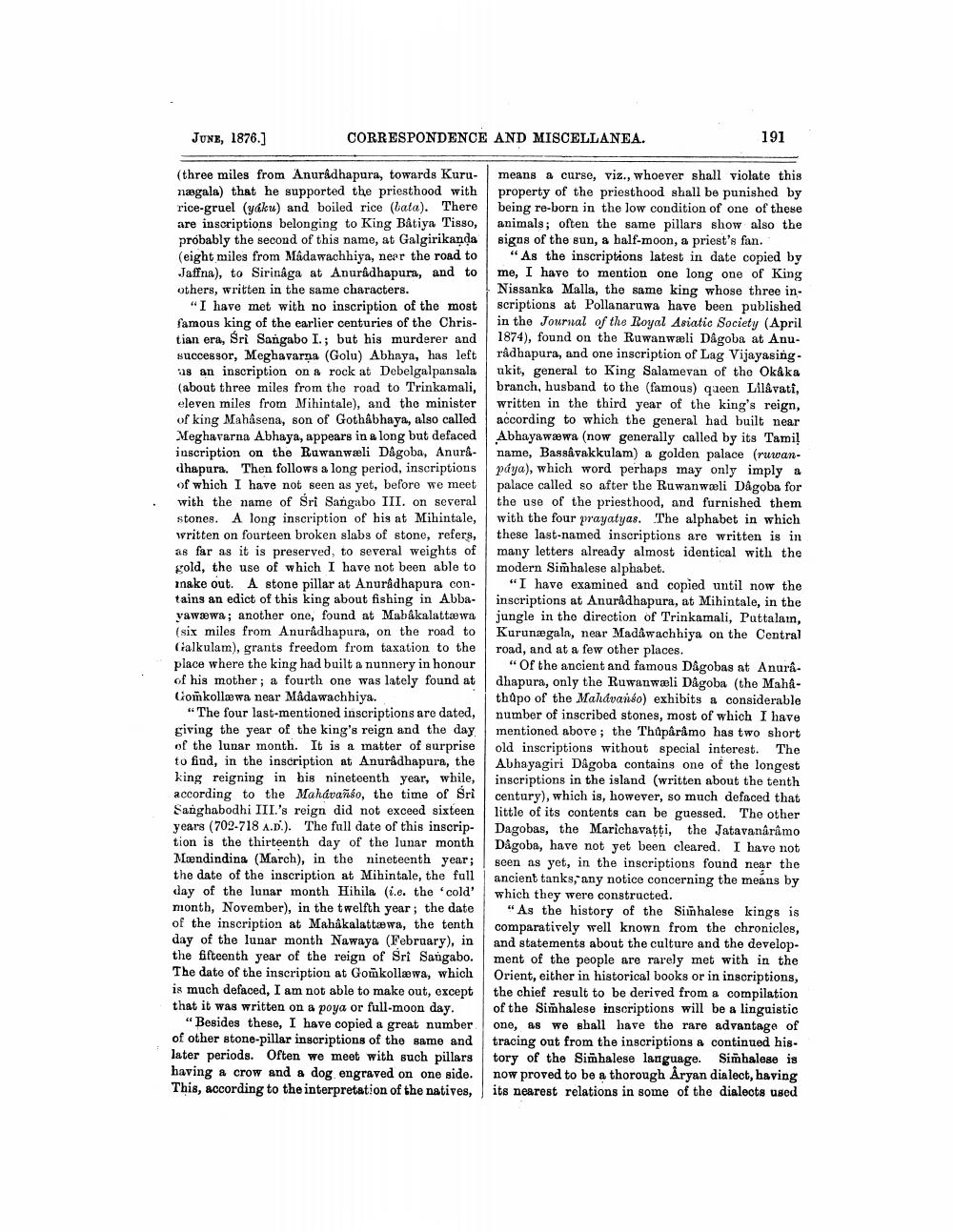________________
JUNE, 1876.]
CORRESPONDENCE AND MISCELLANEA.
(three miles from Anuradhapura, towards Kurunægala) that he supported the priesthood with rice-gruel (yáku) and boiled rice (bata). There are inscriptions belonging to King Bâtiya Tisso, probably the second of this name, at Galgirikanda (eight miles from Madawachhiya, near the road to Jaffna), to Sirinâga at Anuradhapura, and to others, written in the same characters.
"I have met with no inscription of the most famous king of the earlier centuries of the Christian era, Sri Sangabo I.; but his murderer and successor, Meghavarna (Golu) Abhaya, has left as an inscription on a rock at Debelgalpansala (about three miles from the road to Trinkamali, eleven miles from Mihintale), and the minister of king Mahâsena, son of Gothâbhaya, also called Meghavarna Abhaya, appears in a long but defaced inscription on the Buwanwali Dagoba, Anuradhapura. Then follows a long period, inscriptions of which I have not seen as yet, before we meet with the name of Sri Sangabo III. on several stones. A long inscription of his at Mihintale, written on fourteen broken slabs of stone, refers, as far as it is preserved, to several weights of gold, the use of which I have not been able to Inake out. A stone pillar at Anuradhapura contains an edict of this king about fishing in Abbayawawa; another one, found at Mabákalattawa (six miles from Anuradhapura, on the road to (alkulam), grants freedom from taxation to the place where the king had built a nunnery in honour of his mother; a fourth one was lately found at Gomkollawa near Mâdawachhiya.
"The four last-mentioned inscriptions are dated, giving the year of the king's reign and the day of the lunar month. It is a matter of surprise to find, in the inscription at Anuradhapura, the king reigning in his nineteenth year, while, according to the Mahávañéo, the time of Sri Sanghabodhi III.'s reign did not exceed sixteen years (702-718 A.D.). The full date of this inscription is the thirteenth day of the lunar month Mændindina (March), in the nineteenth year; the date of the inscription at Mihintale, the full day of the lunar month Hihila (i.e. the 'cold' month, November), in the twelfth year; the date of the inscription at Mahakalattawa, the tenth day of the lunar month Nawaya (February), in the fifteenth year of the reign of Sri Sangabo. The date of the inscription at Gomkollawa, which is much defaced, I am not able to make out, except that it was written on a poya or full-moon day.
"Besides these, I have copied a great number of other stone-pillar inscriptions of the same and later periods. Often we meet with such pillars having a crow and a dog engraved on one side. This, according to the interpretation of the natives,
191
means a curse, viz., whoever shall violate this property of the priesthood shall be punished by being re-born in the low condition of one of these animals; often the same pillars show also the signs of the sun, a half-moon, a priest's fan.
"As the inscriptions latest in date copied by me, I have to mention one long one of King Nissanka Malla, the same king whose three inscriptions at Pollanaruwa have been published in the Journal of the Royal Asiatic Society (April 1874), found on the Ruwanwali Dâgoba at Anuradhapura, and one inscription of Lag Vijayasingukit, general to King Salamevan of the Okaka branch, husband to the (famous) queen Lilavati, written in the third year of the king's reign, according to which the general had built near Abhayawawa (now generally called by its Tamil name, Bassâvakkulam) a golden palace (ruwanpaya), which word perhaps may only imply a palace called so after the Ruwanwali Dâgoba for the use of the priesthood, and furnished them with the four prayatyas. The alphabet in which these last-named inscriptions are written is in many letters already almost identical with the modern Simhalese alphabet.
"I have examined and copied until now the inscriptions at Anuradhapura, at Mihintale, in the jungle in the direction of Trinkamali, Puttalam, Kurunegala, near Madâwachhiya on the Central road, and at a few other places.
"Of the ancient and famous Dâgobas at Anurâdhapura, only the Ruwanwali Dâgoba (the Mahathapo of the Mahávanéo) exhibits a considerable number of inscribed stones, most of which I have mentioned above; the Thûpârâmo has two short old inscriptions without special interest. The Abhayagiri Dâgoba contains one of the longest inscriptions in the island (written about the tenth century), which is, however, so much defaced that little of its contents can be guessed. The other Dagobas, the Marichavaṭṭi, the Jatavanârâmo Dagoba, have not yet been cleared. I have not seen as yet, in the inscriptions found near the ancient tanks, any notice concerning the means by which they were constructed.
"As the history of the Sinhalese kings is comparatively well known from the chronicles, and statements about the culture and the development of the people are rarely met with in the Orient, either in historical books or in inscriptions, the chief result to be derived from a compilation of the Simhalese inscriptions will be a linguistic one, as we shall have the rare advantage of tracing out from the inscriptions a continued his. tory of the Simhalese language. Simhalese is now proved to be a thorough Aryan dialect, having its nearest relations in some of the dialects used




